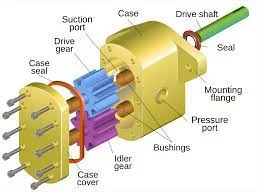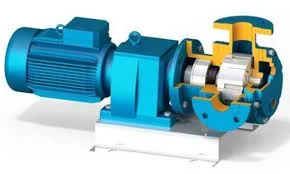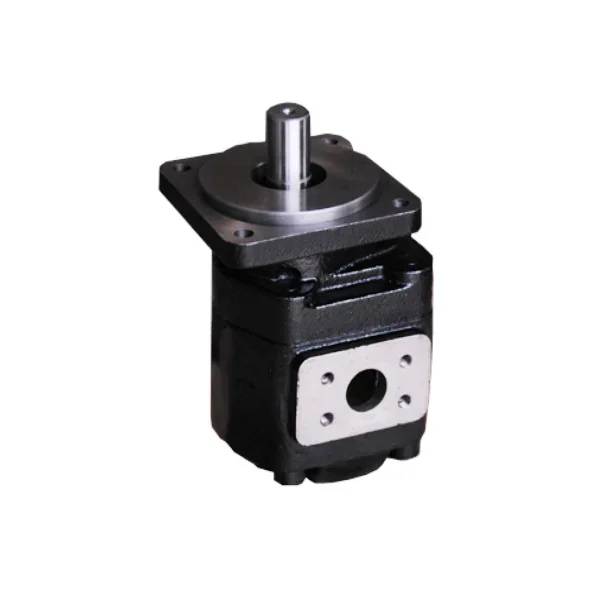Are you tired of constantly battling high energy bills and underperforming gear pumps? Well, fret no more! In today's blog post, we will unveil the secrets to optimizing gear pump efficiency and slashing your energy consumption. Whether you're a mechanical engineer or simply someone curious about how to make your machinery run like a well-oiled machine, this is the ultimate guide for you. Get ready to unlock the potential within your gear pumps and propel yourself towards enhanced performance and cost savings. So, let's dive in and discover how to revolutionize your pumping systems!
Introduction to Gear Pumps
Gear pumps are one of the most common types of pumps used in industrial and manufacturing applications. They are typically used to move fluids with low viscosity, such as oils and chemicals, but can also be used for high-viscosity fluids, such as grease and cement. Gear pumps are positive displacement pumps, meaning they displace a certain amount of fluid with each rotation. This makes them very efficient at moving large volumes of fluid with minimal energy consumption.
Gear pumps work by meshing two gears together inside a pump housing. As the gears rotate, they create a vacuum that sucks fluid into the pump chamber. The fluid is then trapped between the teeth of the gears and pushed through the outlet of the pump as the gears continue to rotate.
Gear pumps are very reliable and have a long lifespan. however, they can start to lose efficiency over time due to wear and tear on the gears. This can cause the pump to require more energy to operate, which can lead to increased operating costs. There are a few things you can do to optimize gear pump performance and reduce energy consumption:
1. Make sure the pump is properly sized for the application.
2. Use a filter to prevent contaminants from entering the pump and damaging the gears.
3. Perform regular maintenance checks to ensure the gears are in proper alignment and free of debris.
4. Use a lubricant specifically designed for your pump type and application to reduce wear on the gears and increase efficiency.

Understanding Efficiency and How to Improve It
It is important to understand what factors affect the efficiency of gear pumps in order to optimize performance and reduce energy consumption. The main factor that affects gear pump efficiency is the viscosity of the fluid being pumped. Higher viscosity fluids will result in lower efficiencies. Another factor that affects gear pump efficiency is the speed at which the pump is operating. Higher speeds will result in lower efficiencies. The third factor that affects gear pump efficiency is the amount of teeth on the gears. The more teeth on the gears, the higher the efficiency. The fourth factor that affects gear pump efficiency is the design of the gears. Helical gears are more efficient than spur gears.
There are a few ways to improve gear pump efficiency. One way is to increase the speed at which the pump is operating. This will reduce the residence time of the fluid in the pump and increase the volumetric flow rate. Another way to improve gear pump efficiency is to decrease the viscosity of the fluid being pumped. This can be done by adding a heat exchanger to heat up the fluid or by using a different type of fluid with a lower viscosity. Another way to improve gear pump efficiency is to use a different type of gear with more teeth. This will increase meshing betweenthe gears and allow for smooth operation at high speeds.

Factors Influencing Pump Efficiency
There are a number of factors that contribute to the efficiency of gear pumps, including the design of the pump, the quality of the materials used, and the manufacturing process. The most efficient gear pumps are those that are designed with care and attention to detail, made from high-quality materials, and manufactured using state-of-the-art processes.
One of the most important factors in determining the efficiency of a gear pump is its volumetric efficiency. This is a measure of how well the pump can move fluid through its system and is directly related to the design of the pump. Volumetric efficiency is influenced by a number of factors, including the size and shape of the pumping chamber, the type of seals used, and how well the pump handles cavitation.
Another important factor in determining pump efficiency is hydraulic efficiency. This measures how well the pump can convert mechanical energy into hydraulic energy, and is influenced by factors such as the design of the impeller and diffuser, and the quality of the materials used in these components. Hydraulic efficiency is also affected by how well the pump handles viscous fluids, as these can cause a loss of energy due to friction.
The final factor that contributes to pump efficiency is mechanical efficiency. This measures how well the pump can transfer energy from its motor to its moving parts, and is affected by factors such as bearing quality, seal quality, and lubrication. In order for a gear pump to be efficient, all three
Practical Strategies for Enhancing Performance
1. Implement a proactive maintenance program: Establishing and maintaining a regular maintenance schedule is key to ensuring optimal performance from your gear pump. This will help to identify potential issues early on, before they have a chance to cause significant damage or downtime.
2. Use high-quality lubricants: Using high-quality lubricants designed specifically for gear pumps can help to improve efficiency and extend the life of the pump.
3. Minimize start-up and shut-down procedures: Whenever possible, try to avoid starting and stopping the gear pump unnecessarily. This can put unnecessary stress on the pump and reduce its overall lifespan.
4. Avoid using the pump at peak demand: If your system can tolerate it, try to avoid running the gear pump at peak demand times. This will help to reduce wear and tear on the pump, and may also help to lower energy consumption.
5. Keep an eye on temperature: Monitoring temperature is important for both the fluid being pumped and the gear pump itself. Running the pump outside of its recommended temperature range can lead to decreased efficiency and increased wear.

Strategies for Reducing Energy Consumption
1. Check the gear pump regularly for any oil leaks.
2. Make sure the gear pump is properly lubricated.
3. Inspect the gear pump for any wear or damage.
4. Repair or replace any damaged or worn parts as necessary.
5. Adjust the gear pump's speed to match the application's requirements.
6. Use a variable frequency drive (VFD) to control the gear pump's speed and further reduce energy consumption.
Common Problems with Gear Pumps and Solutions
If your gear pump is not operating as efficiently as it should, there are a number of common problems that could be the culprit. Here are some of the most common problems with gear pumps and their solutions:
1. Worn or Damaged Gears
One of the most common problems with gear pumps is worn or damaged gears. This can happen over time as the gears rub against each other, causing them to wear down. This can also happen if the gears are made from inferior materials that are not strong enough to stand up to the constant rubbing.
The solution to this problem is to replace the worn or damaged gears with new ones. You will also want to make sure that you use high-quality gears that are designed to withstand the constant rubbing without wearing down.
2. Leaking Seals
Another common problem with gear pumps is leaking seals. This can happen if the seals are old and worn out, or if they were not installed properly in the first place. Either way, leaking seals will allow fluids to leak out of the pump, which can lead to decreased efficiency and increased energy consumption.
The solution to this problem is to replace the old and worn out seals with new ones. You will also want to make sure that you install the seals correctly so that they do not leak in the future.

Conclusion
Gear pumps have long been an effective and efficient way to move fluids. With the proper optimization, they can be even more efficient and save energy. By following these tips on optimizing gear pump efficiency, you can improve performance while reducing energy consumption. This will not only reduce your operating costs but also help you meet environmental standards for waste reduction. Investing in a modern gear pump system with advanced features such as variable speed control is a great way to ensure that your system operates at peak efficiency while preserving resources.
Shanghai AJA Technology Co., Ltd. mainly sells products such as hydraulic motors, cycloidal hydraulic motors, hydraulic gear pumps, and supporting various valves, brakes, gearboxes, steering gear, steering column manufacturing and sales; Widely used in plastics, engineering, agriculture, construction, sanitation, petroleum, lifting, food and fishery CNC machine tools and other industries. Welcome to inquiry if you need to know more about product details or order wholesale.15021387974@163.com